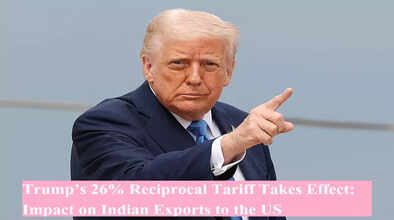Trump’s 26% Reciprocal Tariff Takes Effect: Impact on Indian Exports to the US

Reciprocal Tariff: As of April 9, 2025, the United States has imposed a 26% reciprocal tariff on Indian goods, a move announced by former U.S. President Donald Trump. This tariff is expected to significantly affect Indian exports, especially in key sectors such as electronics, pharmaceuticals, automobiles, and textiles. The policy could reshape trade dynamics between India and the U.S.
✅ Tariff Now in Effect
The 26% import duty officially came into effect on April 9 at 9:31 AM (U.S. time) and applies to goods from India as well as about 180 other countries. This move is seen as part of Trump’s broader “America First” trade strategy, aiming to counter what he calls “unfair” foreign tariffs on U.S. goods.
📉 Indian Exports Set to Become Costlier in the U.S.
Due to the tariff hike, Indian goods will now be more expensive in the U.S. market, reducing their competitiveness. This could disadvantage Indian products in comparison to exports from countries that face lower tariffs. Sectors likely to be hardest hit include:
-
Electronics
-
Automobiles
-
Gems and Jewelry
-
Textiles
💊 Pharma Sector Faces the Biggest Hit
India is a major supplier of affordable pharmaceutical products to the U.S. In FY 2023–24, Indian pharma exports to the U.S. exceeded $12 billion. With the new tariffs, these products will become costlier, potentially reducing demand and shrinking India’s trade surplus.
⚖️ Strain on India-U.S. Trade Balance
Currently, India maintains a trade surplus with the U.S., exporting goods worth $73.7 billion and importing $39.1 billion. However, American trade figures suggest this gap is even wider. The new tariff could disrupt this delicate balance and impact bilateral trade ties.
💬 Why Did Trump Call India the “Tariff King”?
Trump has long criticized India’s trade practices, often calling the country the “Tariff King”. He claims that India imposes unreasonably high duties on American goods, which he labeled as "unfair and brutal." The reciprocal tariff is intended to level the playing field for U.S. exporters.
📊 What Do WTO and GTRI Say?
-
WTO Data: India’s average tariff rate is around 17%, compared to just 3.3% in the U.S.
-
GTRI Report: India imposes a 37.66% tariff on food imports from the U.S., while the U.S. charges only 5.29% on similar imports from India.
🏛️ Indian Government in Strategy Mode
The Indian government has taken this development seriously. A Cabinet meeting was held at 11 AM today, where the impact of the tariff was discussed. The Commerce Ministry is also in consultation with exporters to frame a strategic response.

